Myosotis Cardigan |
||||||||||||||||||||||||||||||||||
 |
 |
|||||||||||||||||||||||||||||||||
Jacket with round yoke, multi-coloured Norwegian pattern and ¾-sleeves with flounce, knitted top down. Size: S - XXXL Piece is knitted in DROPS Cotton Merino.
DROPS 191-36 |
||||||||||||||||||||||||||||||||||
|
INFORMATION FOR PATTERN: GARTER STITCH (back and forth): 1 ridge = knit 2 rows. GARTER STITCH (worked in the round): 1 ridge = 2 rounds. Knit 1 round and purl 1 round. INCREASE/DECREASE TIP (evenly): To calculate how to increase/decrease evenly, use the total number of stitches on row (e.g. 110 stitches), minus bands (e.g. 10 stitches) and divide the remaining stitches by number of increases to be done (e.g. 36) = 2.8. In this example increase by making 1 yarn over after approx. every 3rd stitch. On next row work yarn overs twisted to avoid holes. If decreasing knit approx. every other and 3rd. stitch together. Do not increase/decrease over bands. INCREASE TIP (applies to sides of body): All increases are done from the right side. Work until 8 stitches remain before marker thread, make 1 yarn over, knit 16 (marker thread in the side is in the middle of these 16 stitches), make 1 yarn over (= 2 stitches increased). On next row (wrong side) purl yarn overs twisted to avoid holes. PATTERN: See diagrams A.1 to A.4. Choose diagram for your size (applies to A.1). Diagrams show all rows in pattern seen from the right side. KNITTING TIP-1 (applies to band): On rows with pattern border on yoke work with base colour in pattern border also over the 5 band stitches in each side. KNITTING TIP-2: To avoid the knitting tension to tighten when working pattern, it is important not to tighten the strands on back side of piece. Use a larger needle size when working pattern if needed. RAGLAN: Increase for raglan on each side of the 4 marker threads in every transition between sleeves and body. All increases are done from the right side. Work until 1 stitch remains before marker thread, make 1 yarn over, knit 2 (marker thread is in the middle of these 2 stitches), make 1 yarn over (= 2 stitches increased). On next row (wrong side) purl yarn overs twisted to avoid holes. DECREASE TIP (applies to mid under sleeve): Begin 3 stitches before marker and knit 2 together, knit 2 (marker is between these 2 stitches), slip 1 stitch knitwise, knit 1, pass slipped stitch over stitch worked (= 2 stitches decreased). BUTTONHOLES: Decrease for buttonholes on right band (when garment is worn). 1 buttonhole = work from right side until 3 stitches remain on needle, make 1 yarn over, knit 2 together and finish by knitting 1. On next row (wrong side) knit the yarn over to make a hole. Decrease for first buttonhole on first row from right side after edge in garter stitch in neck. Then decrease the next 6-6-6-7-7-7 buttonholes approx. 7½-7½-8-7½-7½-8 cm apart. ---------------------------------------------------------- JACKET: Work yoke and body back and forth on circular needle from mid front, work top down. Work sleeves in the round on double pointed needles/a short circular needle, top down. An elevation in the back of neck can be worked to get a better fit so that yoke is somewhat higher in the neck. This elevation can be skipped, to make the neck the same at the front and back - see explanation on elevation in pattern. NECK EDGE: Cast on 110-116-120-126-130-136 stitches (including 5 band stitches in each side towards mid front) on circular needle size 3 mm with pistachio. Work 3 ridges in GARTER STITCH - see explanation above. Switch to circular needle size 4 mm and knit 1 row from right side while increasing 36-39-44-38-43-46 stitches evenly - read INCREASE/DECREASE TIP and remember BUTTONHOLES on right band - see explanation above = 146-155-164-164-173-182 stitches. Purl 1 row from wrong side (knit bands). Now work elevation in the back of neck or start to work the yoke if you don’t want an elevation. ELEVATION IN BACK OF NECK: Skip this paragraph if you do not want an elevation. Insert 1 marker in the middle of row (in S, L, XL and XXXL insert marker between the 2 middle stitches, in M and XXL insert marker in middle stitch = mid back). Begin from right side with pistachio and knit 15-16-17-18-19-20 stitches past marker/stitch with marker, turn, tighten yarn and purl 30-33-34-36-39-40. Turn, tighten yarn and knit 45-49-51-54-58-60, turn, tighten yarn and purl 60-65-68-72-77-80. Turn, tighten yarn and knit 75-81-85-90-96-100, turn, tighten yarn and purl the rest of row (knit band). YOKE: = 146-155-164-164-173-182 stitches. Read KNITTING TIP-1 AND KNITTING TIP-2! Work first row as follows from right side: 5 band stitches in garter stitch, work A.1A until 6 stitches remain on row (= 15-16-17-17-18-19 repetitions of 9 stitches), work A.1B (= 1 stitch) and finish with 5 band stitches in garter stitch. Continue pattern like this. REMEMBER THE KNITTING TENSION! AT THE SAME TIME on row marked with arrow in A.1A increase 21-36-27-39-54-45 stitches evenly = 167-191-191-203-227-227 stitches. Work A.1 (there is now room for 13-15-15-16-18-18 repetitions of 12 stitches). When A.1 is done, purl 1 row from wrong side with off white while increasing 4-0-0-8-4-4 stitches evenly = 171-191-191-211-231-231 stitches (work bands in garter stitch and do not increase over bands). Work next row as follows from right side: 5 band stitches in garter stitch, work A.2A until 6 stitches remain on row (= 8-9-9-10-11-11 repetitions of 20 stitches), work A.2B (= 1 stitch) and finish with 5 band stitches in garter stitch. Continue pattern like this and increase as shown in A.2A. When A.2 has been worked, there are 251-281-281-311-341-341 stitches on needle. Then work with off white until finished measurements. Knit 1 row from right side while increasing 7-1-9-11-1-9 stitches evenly = 258-282-290-322-342-350 stitches. Work next row as follows from wrong side (purl with 5 stitches in garter stitch in each side): Work 41-44-46-51-56-59 stitches (= front piece), insert 1 marker thread, work 52-58-58-64-64-62 stitches (= sleeve), insert 1 marker thread, work 72-78-82-92-102-108 stitches (= back piece), insert 1 marker thread, work 52-58-58-64-64-62 stitches (= sleeve), insert 1 marker thread and work the remaining 41-44-46-51-56-59 stitches (= front piece). There are now 4 marker threads in the piece. On next row (right side) increase for RAGLAN – see explanation above (= 8 stitches increased). Increase like this on every 4th row (i.e. every other row from right side) 4-5-7-7-8-9 times in total = 290-322-346-378-406-422 stitches. Work until piece measures 22-24-26-28-30-32 cm from cast-on edge mid front. Work next row as follows from wrong side: Work 45-49-53-58-64-68 stitches as before (= front piece), slip the next 60-68-72-78-80-80 stitches on 1 stitch holder for sleeve, cast on 8-8-10-10-12-14 new stitches on row (= in the side under sleeve), work 80-88-96-106-118-126 stitches as before (= back piece), slip the next 60-68-72-78-80-80 stitches on 1 stitch holder for sleeve, cast on 8-8-10-10-12-14 new stitches on row (= in the side under sleeve) and work the 45-49-53-58-64-68 stitches as before (= front piece). Remove all markers/marker threads. Finish body and sleeves separately. NOW MEASURE THE PIECE FROM HERE! BODY: = 186-202-222-242-270-290 stitches. Insert 1 marker thread 49-53-58-63-70-75 stitches in from each side = 88-96-106-116-130-140 stitches between marker threads on back piece. Work in stocking stitch back and forth with 5 band stitches in garter stitch in each side towards mid front - remember buttonholes on right band. When piece measures 3 cm from division, increase 1 stitch on each side of both marker threads - read INCREASE TIP (= 4 stitches increased). Increase like this every 6 cm 4 times in total in each side = 202-218-238-258-286-306 stitches. Work until piece measures 26 cm from division. Knit 1 row from right side while adjusting number of stitches to 200-219-238-257-295-314. Purl 1 row from wrong side inside 5 band stitches in garter stitch in each side. Work next row as follows from right side: 5 band stitches in garter stitch, work A.3 until 5 stitches remain on row (= 10-11-12-13-15-16 repetitions of 19 stitches) and finish with 5 band stitches in garter stitch. Continue pattern like this. When A.3 has been worked, there are 280-307-334-361-415-442 stitches on needle. Work 2 ridges back and forth over all stitches. Cast off by knitting from right side - make sure to avoid a tight cast-off edge. Jacket measures approx. 56-58-60-62-64-66 cm from shoulder and down. SLEEVE: Slip the 60-68-72-78-80-80 stitches from stitch holder in one side of piece on a short circular needle size 4 mm and pick in addition up 1 stitch in each of the 8-8-10-10-12-14 stitches cast on under sleeve = 68-76-82-88-92-94 stitches. Insert 1 marker thread in the middle of the 8-8-10-10-12-14 stitches under sleeve and begin round at the marker thread. Work in stocking stitch in the round. When piece measures 2 cm from division, decrease 2 stitches mid under sleeve - read DECREASE TIP. Decrease like this every 3-2-1½-1-1-1 cm 8-11-13-15-16-15 times in total = 52-54-56-58-60-64 stitches. Continue until piece measures 25-23-22-20-19-17 cm from division (shorter measurements in the larger sizes because of wider neck and longer yoke). Switch to double pointed needles size 3 mm. Work 2 ridges in the round over all stitches. Then knit 2 rounds and increase AT THE SAME TIME 16-14-12-10-25-21 stitches evenly on first round = 68-68-68-68-85-85 stitches. Switch back to double pointed needles size 4 mm and work A.4 in the round (= 4-4-4-4-5-5 repetitions of 17 stitches). When A.4 has been worked, there are 108-108-108-108-135-135 stitches on needle. Work 2 ridges in the round. Cast off by knitting but make sure that the cast-off edge is not too tight. Sleeve measures approx. 34-32-31-29-28-26 cm from division. Work the other sleeve the same way. ASSEMBLY: Sew the buttons on to the left band. |
||||||||||||||||||||||||||||||||||
Diagram explanations |
||||||||||||||||||||||||||||||||||
|
||||||||||||||||||||||||||||||||||
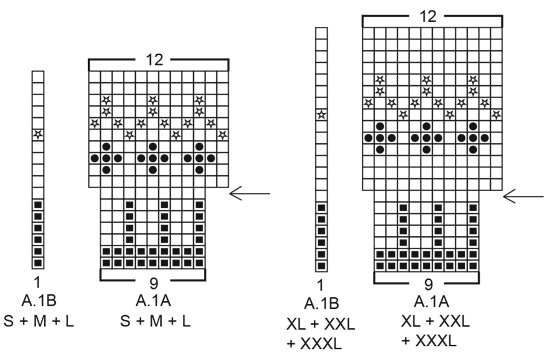
|
||||||||||||||||||||||||||||||||||

|
||||||||||||||||||||||||||||||||||
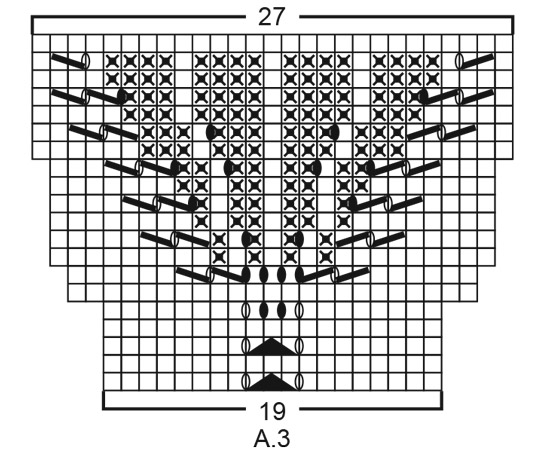
|
||||||||||||||||||||||||||||||||||
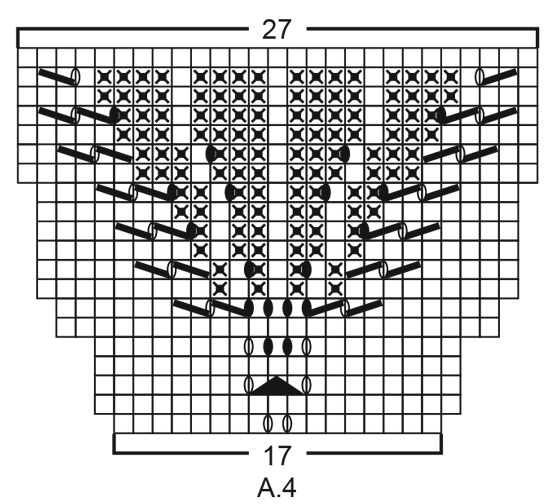
|
||||||||||||||||||||||||||||||||||

|
||||||||||||||||||||||||||||||||||
|
Have you made this or any other of our designs? Tag your pictures in social media with #dropsdesign so we can see them! Do you need help with this pattern?You'll find tutorial videos, a Comments/Questions area and more by visiting the pattern on garnstudio.com. © 1982-2024 DROPS Design A/S. We reserve all rights. This document, including all its sub-sections, has copyrights. Read more about what you can do with our patterns at the bottom of each pattern on our site. |
||||||||||||||||||||||||||||||||||







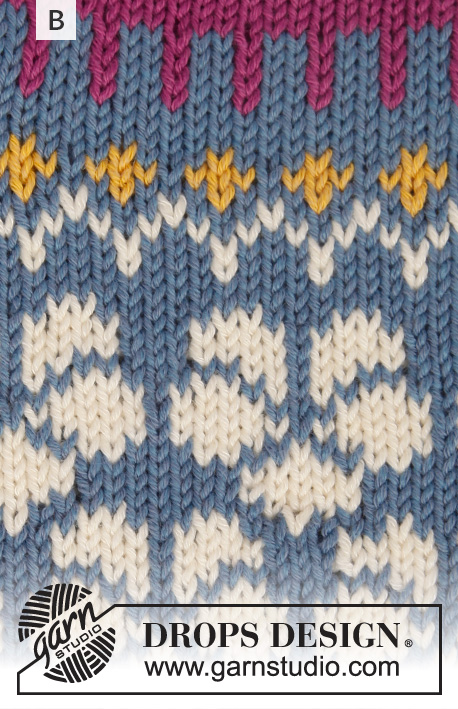


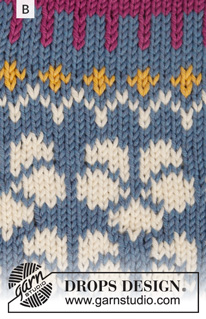


































































Comments / Questions (8)
Hej Undrar var beskrivningen till den gula koftan finns? Något måste ha blivit fel. Mvh
06.09.2020 - 17:27DROPS Design answered:
Hej Maritha. De färgerna du ser på bilden märkt med A är DROPS Cotton Merino 01, 17, 29, 15 (den första färgen ersätter den första färgen i mönstret under garnåtgång osv). Mvh DROPS Design
08.09.2020 - 08:37Aan het einde van de mouw moet ik patroon A4 breien, deze kan ik echter niet meer vinden bij het patroon, is A4 weggehaald?
06.06.2020 - 17:38DROPS Design answered:
Dag Marjan,
Nee, hij staat er wel bij hoor, het is het onderste telpatroon, direct boven de maattekening. Misschien dat hij tijdelijk niet goed geladen werd...
07.06.2020 - 14:14There are no notations in how many inches for s-m-l, etc. Am ready to start but need to know that before I start. Thank you.
04.04.2019 - 21:54DROPS Design answered:
Dear Mrs Strahle, all measurements in the chart are in cm - convert and read more about sizing here. Happy crocheting!
05.04.2019 - 09:53Ska diagrammet verkligen se ut så? Likadant i diagrammet för den som är en pullover. I A2, så är den högra blomman väldigt skev jämfört med den vänstra. Ser inte ut så när man tittar på bilderna på den färdiga tröjan. Fler har kommenterat på detta i mönstret för pullover-varianten men ni har inte besvarat dem eller ändrat i mönstret.
12.05.2018 - 04:45DROPS Design answered:
Hei Jennie. På grunn av økningen på den 19 omgangen av A.2a blir mønsteret forskjøvet med 1 maske fra omgang 20 og oppover - dette for at det skal gå opp med både masketall og mønster. Det blir pent og vil ikke virke skjevt på den ferdige genseren. God fornøyelse.
16.05.2018 - 09:49Pourquoi faites vous les modèles tricotés de haut en bas sachant que le suivi du tricot est beaucoup plus difficile à contrôler de cette façon. Je tricote depuis très longtemps et je ne trouve pas que cette méthode soit un plus , pouvez-vous me dire quelles sont les raisons de cette méthode ?
18.04.2018 - 16:53DROPS Design answered:
Bonjour Mme Guillaumond, cette technique est de plus en plus plébiscitée par nos utilisatrices, elle permet notamment de pouvoir essayer l'ouvrage au fur et à mesure et de faire des ajustements individuels (longueur par exemple). Bon tricot!
19.04.2018 - 09:17Precioso patrón, bonitos colores.
15.04.2018 - 22:48Fin den vill jag sticka.
02.01.2018 - 12:10Gelungene Kombination aus Blumenmotiv und Muschelmuster, die möchte ich nacharbeiten
18.12.2017 - 13:46